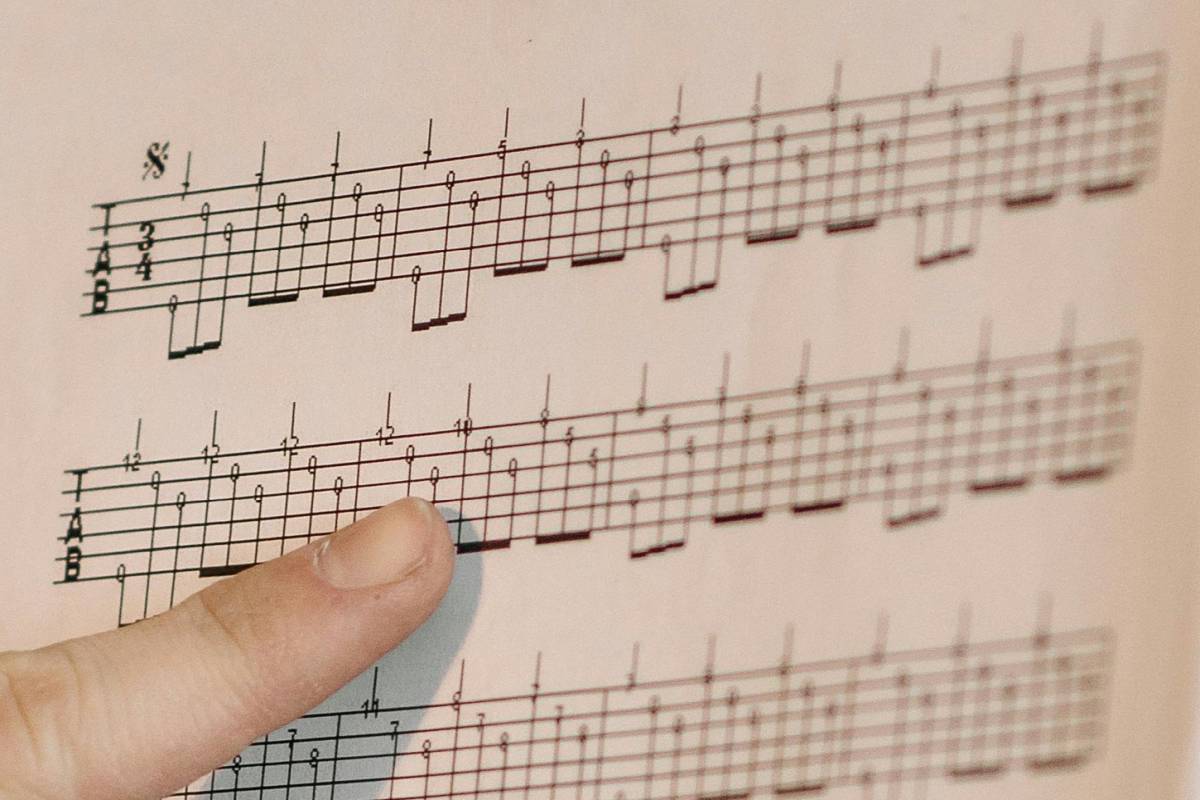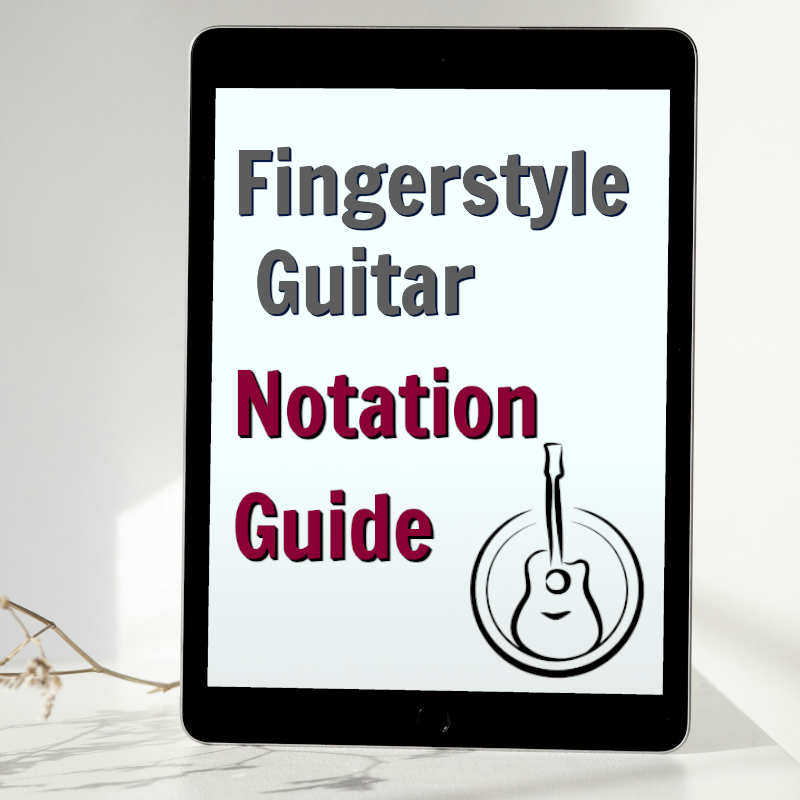If you're new to fingerstyle guitar, here's a guide to reading and understanding fingerpicking guitar tabs.
When I started taking guitar lessons, I got started learning classical guitar, using the Royal Conservatory books.
Since classical guitar methods use exclusively standard notation, I had no idea what guitar tabs were until much later. This was when my teacher explained to me that I was one of the few students who didn't use tab to learn.
Being a young and inexperienced student, this comment made me feel rather smug. So, I totally ignored charts which were written in tablature, and this caused some problems down the line which I'll get into shortly.
Let's go over the basics of guitar tablature, and then we'll tackle specific challenges with reading fingerpicking guitar tabs.
What are Guitar Tabs?
Guitar tabs, or tablature, are a form of musical notation that allows guitarists to read and play music without having to learn to read traditional sheet music.
Tablature, or tab for short, consists of a series of horizontal lines upon which we place numbers that indicate which fret to play on each string. The lines are a visual representation of the strings, with the lowest pitched (thickest string) at the bottom and the highest pitched (thinnest) string at the top.
Unlike sheet music which uses standard notation exclusively, tablature shows you exactly where to place your fingers on the guitar, making it ideal for beginners who are just starting to learn fingerpicking.
What is Standard Notation?
Standard notation is what other musicians usually refer to as sheet music and it's the universal way to represent musical notation.
Standard notation provides a visual representation of the notes that you need to play, such as their height (pitch) and duration. This notation lets the musician easily understand the music, such as the tune (melody) as well as separation between the melody and accompaniment.
While standard notation is a universal language for all instruments, tablature notation is specific to the guitar and is useful mainly to guitarists.
The Basics of Fingerstyle Guitar Tabs
There are two types of tab notation for fingerstyle guitar: Simple or Standard, also known as full or complete.
The simple notation contains only the fret number indications. Fingering and rhythmic information must be provided in a separate staff containing the standard notation version.
One of the main disadvantages of simple tabs, when compared to standard notation, is the absence of rhythmic notation. This means that, unless you're already familiar with the song, it can be challenging to understand the timing and rhythm of the piece just by looking at the tab.
Standard or full tablature is more complete as it also contains rhythmic information. Not only does it provide a visual representation of where to place your fingers on the fretboard and which strings to play, full tablature allows us to distinguish both the bass line (lowest-pitched notes) and melody (main theme).

How To Read Fingerstyle Guitar Tabs
While tabs are useful for learning songs quickly, they don't provide the same level of detail and nuance as standard notation. As a fingerstyle guitar player, you will likely encounter tablature acompanied by a staff containing standard notation.
Here's an example of how fingerpicking tabs are typically notated. Unlike standard guitar tabs, fingerpicking tabs contain symbols to represent special effects used in fingerstyle guitar. The vertical arrow indicates a strummed chord, while the x notes indicate percussion via a thumb slap.

Because fingerstyle guitar involves playing melody and bass at the same time, there is much more information crammed onto the staff as compared to single note soloing.
The Fingerstyle Guitar Notation Guide contains a complete video lesson on understanding guitar tablature.
Letters And Numbers in Tab Notation
Fingerpicking tabs may contain information on which finger to use to pluck the strings. This is particularly true if the tab contains a staff with standard notation. Each finger of the plucking hand is referred to with a letter:
- P for the thumb
- I for the index finger
- M for the middle finger
- and A for the ring finger.
Reading Bass Notes in Fingerstyle Tabs
To represent the bass notes with tablature, notate the bass line played with your thumb using stem down notes. The melody that you play with your fingers should be marked with stem up notes.

One common fingerpicking pattern is the Travis picking pattern. This pattern involves alternating the thumb between two bass strings while the fingers play a melody.
With Travis picking, you can mark the notes that should be played with the thumb using 'p' and the melody using 'i', 'm', and 'a' fingers.
Notating Advanced Fingerstyle Techniques
Other special effects found in fingerstyle guitar, such as harmonics, bends, palm muting, etc. are notated much the same way in fingerpicking guitar tabs as in regular tabs. In order to represent these techniques in tablature, we use special symbols.
Understanding Fingerstyle Percussion Notation
Unfortunately, there is no standard way to notate fingerstyle guitar percussion. The most common technique is to notate percussion as ghost notes. This means that the various parts of the guitar body meant to be struck are notated along different lines of the guitar staff.
I have not had much success in easily understanding this notation, even with the detailed notes provided by guitarists such as Jon Gomm. I recommend the best way is to watch a video or listen carefully to a recording of the fingerstyle guitar song that contains the percussion.
Harmonics in Guitar Tablature
Artificial harmonics, when notated in guitar tabs, must contain the fret number where you place your fretting hand, as well as the fret where the node is located.
In this example, we want to place a finger on the second string in the 2nd fret and simultaneously touch the node at the 21st fret. This will produce a harmonic sounding an octave and a fifth higher than the fundamental.

Tablature vs Notation: Which Is Better?
To indicate a finger position in standard notation, a guitarist must add two numbers beside the note: a circled number to denote the string and a separate number for the finger. Some parts even indicate the fret number in Roman numerals, such as when the notes are guitar harmonics.
I always felt this was a somewhat clunky workaround and a weak point in guitar sheet music. Using guitar tablature provides a more elegant solution to the problem of indication accurate finger placement in my opinion.
On the other hand, I exclusively use standard notation when I transcribe songs from recordings. It's far quicker for me to notate the notes being played rather than write down each individual fret number.
Plus, music notation software will often create tablature automatically and you can always go back and correct the fret numbers later.
In fingerpicking, each finger is assigned to a specific string. Typically, the thumb plays the bass notes and the fingers play the higher notes.
If the tablature does not contain stems pointing a certain direction to help you decide which finger you should use to play each note, you will have to decide yourself which finger pattern to use.
Should You Learn Tabs Or Notation?
When I was learning guitar, I originally believed we could dispense with tabs altogether. However, over the years of teaching guitar and learning songs myself, I came to the realization that there is definitely a place for guitar tablature.
One of the biggest advantages of tabs is that they allow guitarists to learn songs quickly without having to read traditional sheet music. This is particularly useful if you are a fingerstyle guitarist who has not had much formal music training.
However, guitarists who want to take their playing to the next level should consider learning how to read sheet music in addition to tabs. Reading music notation helps you understand that one note can be found in several places on the guitar neck.
My preference is for a guitar part that contains both standard notation and tabs. This provides for the most accurate notation possible, indicating which notes to play as well as how to play them.



